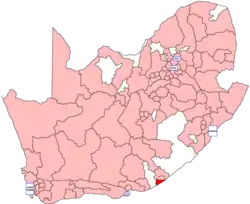East London City (Afrikaans: Oos-Londen-Stad; known simply as East London (Oos-Londen) prior to 1924) was a constituency in the Cape Province of South Africa, which existed from 1910 to 1994. The seat covered the urban area of its namesake city, a major port and the second-largest city in the Eastern Cape. Throughout its existence it elected one member to the House of Assembly and one to the Cape Provincial Council.
Franchise notes
When the Union of South Africa was formed in 1910, the electoral qualifications in use in each pre-existing colony were kept in place. The Cape Colony had implemented a "colour-blind" franchise known as the Cape Qualified Franchise, which included all adult literate men owning more than £75 worth of property (controversially raised from £25 in 1892), and this initially remained in effect after the colony became the Cape Province. As of 1908, 22,784 out of 152,221 electors in the Cape Colony were "Native or Coloured". Eligibility to serve in Parliament and the Provincial Council, however, was restricted to whites from 1910 onward.
The first challenge to the Cape Qualified Franchise came with the Women's Enfranchisement Act, 1930 and the Franchise Laws Amendment Act, 1931, which extended the vote to women and removed property qualifications for the white population only – non-white voters remained subject to the earlier restrictions. In 1936, the Representation of Natives Act removed all black voters from the common electoral roll and introduced three "Native Representative Members", white MPs elected by the black voters of the province and meant to represent their interests in particular. A similar provision was made for Coloured voters with the Separate Representation of Voters Act, 1951, and although this law was challenged by the courts, it went into effect in time for the 1958 general election, which was thus held with all-white voter rolls for the first time in South African history. The all-white franchise would continue until the end of apartheid and the introduction of universal suffrage in 1994.[1]
History
East London, like much of the Eastern Cape, was a stronghold of the pro-British side of South African politics and had a largely English-speaking electorate. Its first MP, Sir Charles Preston Crewe, had previously represented Aliwal North in the Cape Parliament as a Progressive, and sat for East London as a member of that party’s successor, the Unionist Party. He held the seat in 1915, despite a growing Labour vote, but the by-election caused by his resignation in 1919 was won by Labour candidate James Stewart. Stewart held the seat in 1920, the best election in the Labour Party’s history, but lost it to the South African Party (which by then had merged with the Unionists) in 1921. Stewart returned in a 1921 by-election, and fellow Labour member Andrew Latimer won the seat in 1943 against no major-party opposition, but with those exceptions, the seat now became safe for the SAP and its successor the United Party. The UP would hold the seat without interruption from 1948 until 1977, when it was captured by Gert Myburgh of the governing National Party. Myburgh stood down at the 1981 election, but East London remained an NP seat for the remainder of its existence.
Members
[2]
[3]
[4]
[5]
[6]
Detailed results
Elections in the 1910s
Elections in the 1920s
Elections in the 1930s
Elections in the 1940s
References
- ^ "EISA South Africa: Historical franchise arrangements". Eisa.org.za. Archived from the original on 9 May 2013. Retrieved 6 July 2012.
- ^ a b c d e f g h i Schoeman, B.M. (1977). Parlementêre verkiesings in Suid-Afrika 1910-1976. Pretoria: Aktuele Publikasies.
- ^ South Africa 1980/81: Official Yearbook of the Republic of South Africa. Johannesburg: Chris van Rensburg Publications.
- ^ South Africa 1983: Official Yearbook of the Republic of South Africa. Johannesburg: Chris van Rensburg Publications.
- ^ Government Gazette of South Africa, No. 10751. 22 May 1987. Pretoria: Government of South Africa.
- ^ Government Gazette of South Africa, No. 12109. 20 September 1989. Pretoria: Government of South Africa.
